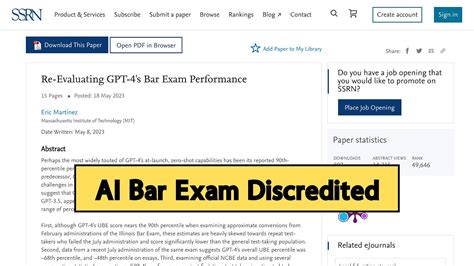A recent study has reignited the debate about the limitations and capabilities of advanced AI models like GPT-4, particularly in passing highly specialized exams such as the bar exam. It’s essential to delve beyond the initial claims of high percentile scores and examine the nuanced factors that offer a clearer, albeit more complex, picture. The abstract of the study argues that although OpenAI claimed GPT-4 scored within the 92nd percentile on the bar exam, more critical evaluations placed its performance at a far more modest 15th percentile on essays when matched against individuals who passed the exam.
Bromeo comments that this revised ranking still positions GPT-4 within the range of bar-passing candidates. This metric, while still noteworthy, reflects a need to adjust expectations. Indeed, GPT-4’s overall score across all test sections was calculated to sit around the 69th percentile—a middle ground that might temper some of the more ambitious claims. Falcor84 reiterates that such performance is indeed impressive but not groundbreaking.
To further understand this phenomenon, it’s critical to consider the fundamental differences between human and machine assessments. As radford-neal pointed out, bar exams are designed to evaluate humans, not AI. These exams test capabilities beyond raw memorization, including ethical considerations, situational judgment, and human empathy—traits an AI like GPT-4 cannot authentically emulate. This sentiment is echoed in the legal community, which views memorization as less critical than analytical abilities in actual legal practice.
anon373839 pointed out the significant gap between memory-based tasks and genuine legal analysis. This highlights inherent challenges in AI mimicking human problem-solving and decision-making processes. Jensson emphasized that while GPT-4 might regurgitate learned content impressively, it lacks the flexibility to adapt to unique, context-specific cases, something a human lawyer does continuously. The bar is an artificial construct of cognitive evaluation—not a true measure of what it takes to practice law effectively.
The conversation invariably gravitates towards the pragmatic applications of AI in legal practice. jeffbee posits that models like GPT-4, trained specifically on legal texts, could revolutionize legal research and document analysis by serving as comprehensive, albeit ‘lossy’, knowledge compendiums. Despite issues of ‘plausible but made-up claims’, these tools can greatly augment legal professionals by automating initial research tasks. However, the critical eye is needed to validate outputs, as violet13 cautioned. Much like the concern over GitHub Copilot’s generated code, the validity and reliability of AI-generated legal texts must always be scrutinized.
Further complicating the discourse are opinions like those of thehoneybadger, who suggests that passing the bar exam is almost a low-bar achievement for advanced NLP models. The formulaic nature of legal writing and the structured demands of exams make them susceptible to high-scorers among AI. What is perceived as a formidable academic hurdle for humans often translates to a straightforward computational exercise for machines. This shows that the real challenge lies beyond mere exams—entering the realm of adaptive, intuitive, and context-rich decision-making in legal practice.
Moreover, the concerns extend to other professional fields supposedly threatened by AI. As highlighted in some comments, while there is speculation about AI replacing CEOs and other high-stakes roles, the consensus remains that human qualities like leadership, vision, and ethical governance are irreplaceable. The nature of these roles involves a high degree of unpredictability, context, and humanity—qualities not easily replicated by even the most sophisticated AI models.
The implications of this discussion are tremendous for the future of professional training and evaluation. The conversation is no longer about whether AI can pass an exam but how it can reliably assist professionals without replacing the nuanced expertise built over years of human experience. As we push frontiers in AI, sectors like law, medicine, and business must consider the ethical and practical dimensions of integrating AI into their practices.
In conclusion, while GPT-4 and similar models represent leaps in artificial intelligence, their application comes with caveats that cannot be ignored. The legal field, filled with complexities and human-specific criteria, is a prime example of where AI can extend, but not replace, human capacity. By recognizing both the achievements and limitations of such technologies, we can better navigate the future landscape where AI and human expertise coalesce to drive progress.


Leave a Reply